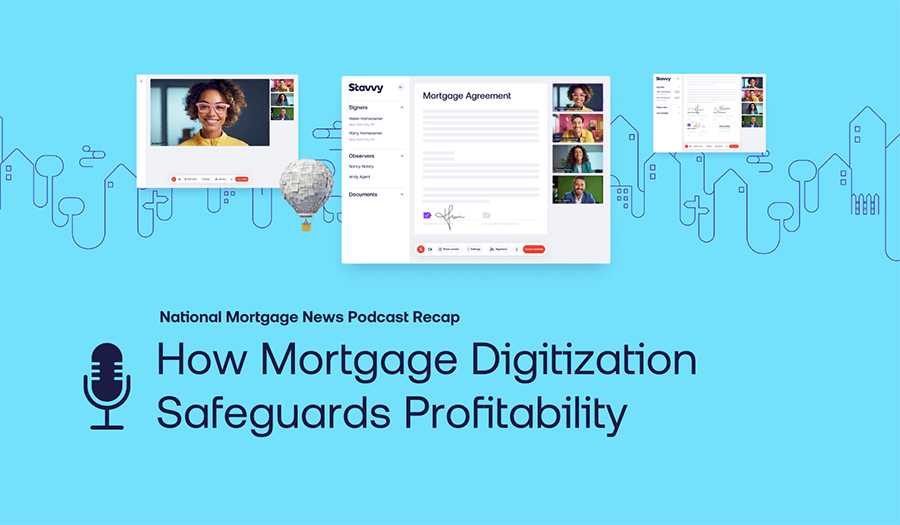We recently had the honor of moderating a HousingWire Lunch and Learn Panel featuring Mark McArdle of the Consumer Financial Protection Bureau (CFPB), Wendy Lee of McCalla Raymer Leibert Pierce, Courtney Thompson of Consigliera LLC, and Stavvy Co-founder, Kosta Ligris. We dove into the recently issued final CFPB rules focused on bringing additional protections to consumers during the COVID-19 pandemic as federal relief and foreclosure moratoriums are coming to an end. Stavvy has taken to the front-lines as the first Remote Online Notarization provider to specifically adapt its platform to support the servicing industry.
Here, we summarize existing mortgage protections for consumers, the changes that the latest set of rules will bring, and some of the key impacts on the industry.
Understanding Existing Mortgage Protections for Consumers
The CFPB was established about ten years ago with the goal of protecting consumers from unfair, deceptive, or abusive practices relating to financial matters. Following the so-called “Great Recession” in 2007-2008 that was caused in part by the subprime mortgage crisis, the Bureau was created to provide a single point of accountability for enforcing federal consumer financial laws and protecting consumers in the financial marketplace.
In 2014, the CFPB established a new set of Mortgage Servicing Rules to, according to the CFPB’s executive summary, “improve the information consumers receive from their servicers, enhance the protections available to consumers to address servicer errors, and to establish some baseline servicing requirements that will provide additional protections for consumers who have fallen behind on their mortgage payments.” This included requirements for the timing and details included on billing statements, ample notification in advance of any interest rate adjustments, promptly crediting accounts following a payment, etc.
When COVID-19 hit in 2020, the CFPB issued a moratorium that prohibited mortgage servicers from making a foreclosure referral or completing related loan modifications, in an effort to protect consumers in a time of extreme uncertainty.
What’s Changing with the CFPB’s New 2021 Rules?
The new “2021 Mortgage Servicing COVID-19 Rule” (or 2021 Rule) amends the original COVID-19 safeguards by allowing the housing market to start its return to normalcy while still providing safeguards for consumers. These updated guidelines will allow consumers to have a fair chance at being evaluated properly in the event of a possible foreclosure, provide servicers with more tools to manage delinquent loans in their portfolio, arm all parties involved with more information, and give both borrowers and lenders more time in the event of a loan modification or foreclosure.
As described by the CFPB’s Mark McArdle during the session, the Rule is essentially broken down into three primary issues to support impacted consumers as the pandemic and the federal forbearance protection run dry:
- Codifying the need to make live contact with consumers eligible for loss mitigation and educate them with specific information.
- Permitting a wide variety of streamlined loan modifications, and removing the requirement for formal paper applications. This also includes specific requirements about following up with the consumer if a streamlined modification is not successful.
- Offering impacted consumers additional time to apply for loss mitigation so that unnecessary foreclosures (but not all foreclosures!) are prevented.
Practical Implications of the Rule on the Industry
Trusted Stavvy advisors Courtney Thompson (on the servicing side) and Wendy Lee (on the default legal network side) helped us break down what this all means as we move forward into 2022.
First, the industry knows that there are record breaking volumes of loans that have to move through both the loss mitigation and foreclosure processes in the next 12 months--with big hits in late September 2021 and in January 2022. In fact, Mark cited an estimate that there may potentially be 15,000 borrowers seeking assistance from servicers every single day during that period.
Second, there’s recognition within the industry that the “old way” of doing things -- pen, paper, and face-to-face -- with previous staffing levels is untenable. The industry is, of course, rushing to scale (and train) humans to support the servicing roles. But certain industrious servicers, and law firms, are seeking out “what’s better” for the underlying processes in both technology and key partnerships in the industry.
During the webinar, Courtney commended the CFPB for its transparency during the process developing these latest rules. There were on-the-record discussions with the industry, and the Bureau not only listened to feedback but incorporated it in their final iteration of the 2021 Rule. The result is a very clear, very consistent process that addresses many of the aspects the industry needed. The entire panel (along with almost everyone I’ve talked to in the industry) agrees that this level of communication and synergy between regulatory bodies and among the biggest industry players was key in pivoting to the realities of COVID-19, and that continued success relies on continuing this synergy.
The Road Ahead: How Fintech (and Stavvy) Can Help
Fintech and financial institution partnerships have been garnering a lot of attention in the mortgage space over the last few years, but like digital origination, sometimes adoption can be slow. The banking, finance, and especially mortgage industries are infamously conservative.
Wendy noted that the default legal network faces many constraints that have proved challenging -- for instance, unlike other industries, they are unable to adjust pricing dynamically to adapt to a time of uncertainty like this one. But one of the areas that is ripe for innovation for the industry is in document execution. Streamlining and digitizing the execution of documents not only improves the experience for the consumer, but allows law firms like hers to process cases faster and more accurately.
Courtney shared the success she had partnering with Stavvy for in both digital loss mitigation in the Spring of 2021, as well as other partnerships she has formed to bolster the use of fintech---and provide a roadmap for companies looking to partner with financial institutions that are traditionally seen as innovative.
Stavvy is the first and only digital servicing platform purpose-built for the mortgage industry by veteran banking, security and legal professionals. Stavvy helps mortgage servicers execute remote transactions conveniently and securely, with tools like digital signatures, RON, identity proofing, automatic video recordings, encrypted file transfers, and more.
Learn more about how the  is taking real estate beyond documents.
is taking real estate beyond documents.



![[Webinar Recap] Advancing Your Digital Default Servicing Strategy](https://blog.stavvy.com/hubfs/advancing-your-digital-default-servicing-strategy-blog-recap.png)